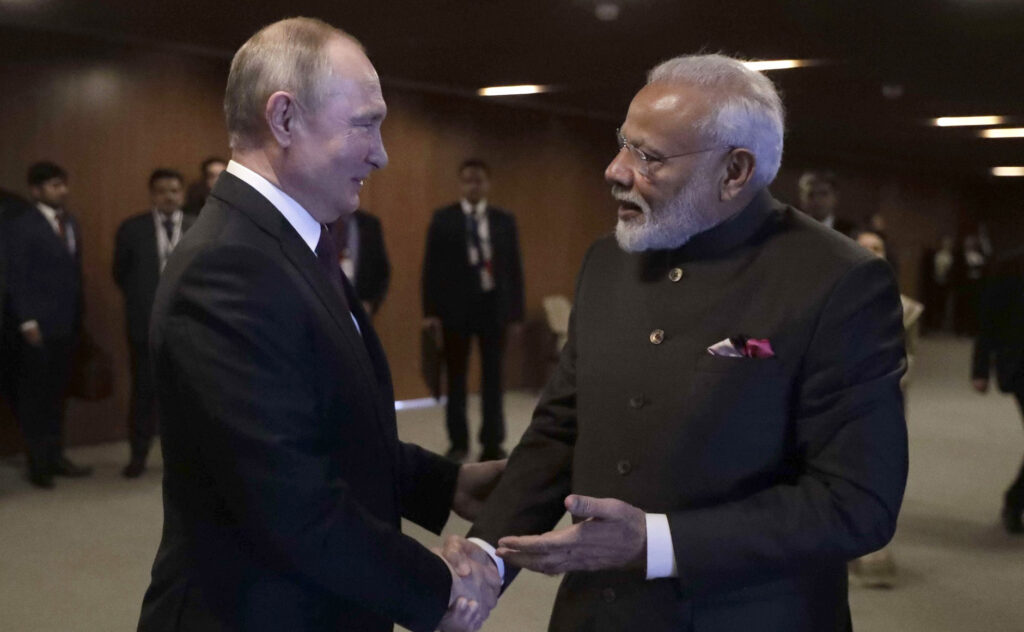India has gone from neutrality to “multi-alignment”. It does not condemn the Russian aggression in Ukraine and rejects international sanctions. In fact, it is buying Russian hydrocarbons and fertilizers en masse. To justify themselves, Indian leaders refer to Kautilya, author of the Arthashastra, an ancient indigenous form of Realpolitik, while giving moral lessons to the West. The “global South” is thus reinventing the world. However, the Russian-Indian partnership raises questions.
In South Asia and the Indian Ocean, Russia’s strategic partner is the Union of India. These ties were forged in the Soviet era, under Indira Gandhi, and were renewed at the end of the 1990s, when Yevgeny Primakov, Foreign Minister then Prime Minister under Yeltsin, set up “anti-hegemonic coalitions”. The aim, it was believed, was to rebalance relations with the United States and the West in order to change the terms of trade. In truth, Moscow was already working to rebuild an opposition force.
A partnership forged during the Cold War
The close relationship between Moscow and Delhi is reflected in energy cooperation agreements, a military-industrial partnership — half of India’s military equipment is of Russian-Soviet origin1 — and regular naval exercises (“Indra” exercises). Only last year, the Indian Navy took part in the “Vostok 2022” exercises. Other exercises are conducted within the multilateral framework of the SCO (Shanghai Cooperation Organization).
Russia, whose role was essential in promoting the BRICS format (Brazil-Russia-India-China-South Africa), also supported India’s SCO membership. This was done in 2017, along with the integration of Pakistan, a historical ally of China. For Narendra Modi and the Hindu nationalists of the BJP2 (Bharatiya Jana Sangh), joining the SCO is part of the “Neighbourhood policy”; in a way, a policy of “zero problems” with its neighbors.
Before the war in Ukraine, however, Russia hardly had the will or the means to accompany India’s rise to power. The area of relevance of its grand strategy was and remains post-Soviet Eurasia, considered as a “near abroad”3. Russia’s naval presence in the Indian Ocean remained limited, unmatched by that of the United States and its main allies. In the 2000s, the “war on terror” even led to the deployment of Western armadas in the Indian Ocean, a platform for power projection toward Afghanistan (Operation Enduring Freedom).
Western capitals, aware of the new balances in the making of what was not yet called the Indo-Pacific zone, were working to establish a new relationship with India4. In 2006, Washington and Delhi signed a cooperation agreement in the field of civil nuclear energy. Paris was working to export its warplanes and naval technology. As a result, the Soviet quasi-monopoly on arms sales to India was gradually ending. More broadly, Brussels began negotiating a free trade treaty with Delhi. Israel, Australia and Japan are also involved in the process. Since Brexit, the United Kingdom has been negotiating on its own behalf.
These prospects exceed what Russia would be able to offer India. All the more so since Moscow favors its links with China, without being able to benefit from a diplomatic counterweight in the great Asian theater (Moscow seeks to preserve a Vietnamese “sphere of privileged interest”). However, hostility between Beijing and Delhi prevails, due to major territorial disputes and the close rear alliance that China and Pakistan have forged.
Before the East Asian countries and their Western allies were confronted with Beijing’s territorial and maritime claims in the so-called “Asian Mediterranean seas” (South and East China Seas), India had to deal with Chinese ambitions at an early stage. It may have won the four wars that opposed it to Pakistan (1947, 1965, 1971, 1999) but its army was defeated in the Sino-Indian war of 1962. Jeopardized as soon as the PLA (People’s Liberation Army) troops entered Tibet in 1950, Nehru’s Third World policy, which involved an agreement with China, revealed its vacuity. Beijing even argued that American aid to India would deprive it of the role it had claimed in the Third World, a claim that had been explicit since the Bandung Conference (18-24 April 1955).
The primacy of the Chinese threat
In 1962, Chinese troops crossed the McMahon Line5 to take up positions on the Himalayan foothills, overlooking the Brahmaputra. Although the Brahmaputra loop and the Assam region were subsequently evacuated, China acted differently on the western edge of the Indo-Chinese borders, where Aksai Chin, a piece of Kashmir, was annexed (Aksai Chin corresponds to a part of the Ladakh plateau). Since then, Delhi has been demanding the return of this territory. In return, Beijing disputes the rightful membership of Arunachal Pradesh in the Indian Federation.
In the summer of 2017, China and India again clashed over the Doklam plateau in western Bhutan, which Beijing has decided to militarize6. In 2020 and 2021, there were incidents in Sikkim, a small state in the Union of India that borders Tibet (People’s Republic of China) and Nepal, as well as on the Ladakh plateau in the far north of India, bordering Tibet. The Chinese armed forces are challenging the Line of Actual Control (LAC). After clashes which probably caused several dozen deaths on both sides, it pushed its advantage. About 1,500 km² passed under the control of the Chinese armed forces7.
At the same time, Beijing has continued to strengthen its alliance with Pakistan. It has given it access to nuclear weapons and supports its position on the Kashmir issue. Launched in 2013, the vast “New Silk Roads” program has also given a major boost to the “string of pearls” strategy in the Indian Ocean8 , to the point of challenging Delhi’s role in the “Indian Lake” (the former “British Lake”).
The same project includes the opening of a logistical corridor through Pakistan to the port of Gwadar (financed by Beijing), and takes the form of a strategy of encircling India. Moreover, China has failed to firmly and explicitly condemn the terrorism of Islamist movements supported to varying degrees by the Pakistani “deep state”, in the name of the struggle for the reattachment of the part of Kashmir that is outside Islamabad’s control.
In sum, India is under attack on its Himalayan borders (3,500 km), while its naval and maritime ambitions in the Indian Ocean are countered by China. This leads Delhi, in agreement with Tokyo, to promote the Indo-Pacific concept . Established in 2007, the “Indo-Pacific Quad” is its strategic extension. After falling off the radar, it has been revived in recent years9. Delhi and Tokyo are driving the “Freedom Roads” agenda; Washington and Brussels are asserting their vision of East-West routes and infrastructure10.

India challenged in South Asia
Without being a formal alliance, the Quad, the grouping between the United States, Australia, Japan and India, aims to counteract the People’s Republic of China. It is open to other powers in the region, including those of ASEAN (Association of Southeast Asian Nations), called the “Quad +”. Occasionally, France is not above joining military exercises conducted within this framework. The demands of Western unity and France’s desire to be a responsible power in the Indo-Pacific zone should lead it to join this “Quad +”. It is true that this requires greater clarity with regard to Taiwan11.
The Quad, the set of bilateral relations between India and Western powers, as well as the military-industrial cooperation established with the same in the post-Cold War period, thus open up perspectives for Delhi other than those proposed by “Russia-Eurasia”, which is obsessed with the post-Soviet area and the Arctic. All the more so since the failure of its troops in the Ukrainian theater exposes for everyone to see the limits of Russia’s military art, of its “combat proven” equipment (in Syria) and of the “brilliant strategist” who rules in the Kremlin. If only for economic and industrial reasons, it will in any case be difficult for Moscow to maintain its positions on the arms market12.
Also, and above all, the war in Ukraine is moving in the direction of closer ties between Russia and China, to the point that many commentators are finally willing to talk about a Sino-Russian alliance13. From Moscow, India can be seen as an example of a country that has been able to develop its own economy. From Moscow’s point of view, India can be of diplomatic and economic service, but it does not carry much weight in terms of grand strategy and global geopolitics. Faced with the “collective West”, the Russians and Chinese are driven by a shared hostility and the belief that the future belongs to them. They are following the logic of a great hegemonic confrontation.
In truth, Indian should be aware of the formation on its northern borders of a vast Sino-Russian Eurasia that would claim to speak and act on behalf of the whole of Asia and the “global South”. Especially since Beijing uses the SCO, which it supervises with Moscow, to reduce India’s diplomatic room for manoeuvre on the international scene. The BRICS forum, whose ideological oversight is provided by the same group, does not give it any more space14.
Finally, Beijing has allies within SAARC (South Asian Association for Regional Cooperation) and BIMSTEC (Bay of Bengal Initiative), both of which focus on South and Southeast Asia15. Significantly, no country in the Indian subcontinent and its periphery has condemned Chinese actions on the Ladakh plateau. Thus, there will be no South Asian bloc, led by Delhi, that is able and willing to counteract China. It is in the West and its Asia-Pacific allies (see AUKUS) that India will find partners, and even allies, determined to counter Beijing.
By way of conclusion
Hindu nationalism would still have to distance itself from the “sublime lie” of autochthony (to the point of denying the Indo-European fact), and favor a maritime and global interpretation of the long history of the Indian subcontinent. As a regional crossroads of an Afro-Eurasian system of exchanges, medieval and modern India was situated between East Africa, the Islamic world, Upper Asia and the Far East. Only by turning toward the open sea, more precisely toward the maritime powers of the West and the Asia-Pacific, will it be able to face China’s grip, in Eurasia as in the Indo-Pacific. Putin’s “Russia-Eurasia” will never be more than an unreliable provider.
Indian diplomats and strategists should know that invoking an ancient collection of stratagems (the Arthashastra), or exploiting windfall effects on world markets (oil, fertilizer and grain), cannot be a substitute for high politics. As for Western powers, they will have to pressurize India, to exploit the situation in order to detach it from Moscow. Without aiming to get this “civilization-state” to switch purely and simply to the West, because India is too massive and self-centered for its leaders to make such a drastic choice. In short, it is a question of practicing the art of diplomacy, an exercise that combines persuasion, cooperation and coercion. An exercise in classicism.
Associate professor of history and geography and researcher at the French Institute of Geopolitics (University of Paris VIII). Author of several books, he works within the Thomas More Institute on geopolitical and defense issues in Europe. His research areas cover the Baltic-Black Sea region, post-Soviet Eurasia, and the Mediterranean.
Footnotes
- It was about 80 percent until 2014. The first international sanctions taken after the manu militari annexation of Crimea and the start of a hybrid war in the Donbas, as limited as they were, still have an effect on the Russian arms industry today.
- Narendra Modi and the BJP won a majority in the lower house in 2014. Prime Minister Modi’s Hindu nationalism marks a departure from the policy of economic openness that began in the 1990s. In fact, nationalism rhymes with protectionism. Nevertheless, the goal of transforming India into the world’s new factory and making its economy the third largest in the world requires international trade negotiations.
- We need to bear in mind that the doctrine dates from 1992. It therefore predates the first enlargement of NATO, decided in 1997 and carried out two years later. Similarly, the Tashkent Treaty (1992), on which the CSTO (Collective Security Treaty Organization) is based, preceded NATO enlargement. These facts are seldom mentioned.
- Although the concept of “Indo-Pacific” zone was used as early as 1924 by German geographer Karl Haushofer, it has only recently spread, taking on a new value and meaning with the rise in power of the People’s Republic of China. In 2007, during a visit to India, Japanese Prime Minister Shinzo Abe used the term Indo-Pacific for the first time before the Indian Parliament, evoking The Confluence of the Two Seas, the title of a book written by a 17th century Mughal prince (Japan and India are at the two ends of this Indo-Pacific region). The concept is also commonly used in Australia (White Paper on Defense, 2013) and even in Indonesia, two countries located at the crossroads of the Indian and Pacific Oceans. Across the Atlantic, the expression was used by Hillary Clinton in 2010 (“Indo-Pacific Basin”). Since then, the Indo-Pacific region has been the United States’ “priority theater” (National Security Strategy, 2017). In France, the Indo-Pacific theme is becoming increasingly important on the strategic and geopolitical levels (an Indo-Pacific defense policy was presented in June 2018). In the background, the power ambitions of the People’s Republic of China, which, from the strategy of the “string of pearls” to the “New Silk Roads” (the Belt and Road Initiative), is developing power and influence, and this from the “Asian Mediterranean seas” (South and East China Seas) and the Strait of Malacca to the Arabian Gulf, the Strait of Bab El-Mandeb as well as to the eastern coast of Africa. In short, “the Indo-Pacific is the former Asia-Pacific area, plus India, which is the rising power in the face of China” (Jean-Luc Racine), and the geopolitical challenge is to contain Beijing’s ambitions. Since 2020, the European Union has also had a strategy for the Indo-Pacific, a point of balance between the strategies of the member states in the region (France, Germany, the Netherlands and Italy in particular).
- Established in 1914 on the basis of an agreement between the United Kingdom and Tibet, the McMahon Line delineates the North Eastern Frontier Agency (present-day Arunachal Pradesh, a member state of the Union of India), an outpost of the Indian Empire in the eastern Himalayas. On the other side of this line, Tibet then enjoyed de facto independence, its legitimacy reinforced by this agreement. In 1947, when India reached independence (Union of India and Pakistan), the McMahon Line separated Tibet from the Union of India. After the Chinese invasion of Tibet in 1950, this boundary became one of the segments of the border between the Union of India and China (the Line of Actual Control is articulated on the Johnson and McCartney lines in the north-west and the McMahon Line in the north-east). By extension, the McMahon Line refers to the issue of India’s northern borders, the difficult Sino-Indian relations and the Tibet issue.
- See Julien Bouissou, “Face-à-face tendu entre la Chine et l’Inde au Bouthan”, Le Monde, July 31, 2017.
- See Sophie Landrin, “Dans l’Himalaya indien, l’implacable grignotage de l’armée chinoise”, Le Monde, August 9, 2022.
- A network of Chinese bases and support points, from Southeast Asia to the Persian Gulf and Djibouti. The name is American. When it first appeared, it was a good idea to point out America’s paranoia. When tested by the facts, this “string of pearls” was one of the first signs announcing the “New Silk Roads”.
- The Indo-Pacific Quad is a cooperative structure that includes the United States, Japan, Australia and India. Founded in 2004 to address the effects of the Asian tsunami, the Quad was formalized in 2007 on the sidelines of an ASEAN (Association of Southeast Asian Nations) summit. Re-launched in November 2020, the cooperative structure held a virtual summit the following year, with its heads of state and government issuing a collective statement (March 12, 2021). On the following September 24, Joe Biden and the United States hosted a real summit of the Quad. Beyond the joint military exercises in which France is sometimes involved, the cooperation also covers climate change, the current pandemic, digital technology and the issue of semiconductor supply chains. Its members are in favor of a “free and open Indo-Pacific region.”
- It was the United States that, as early as the 1990s, took up the theme of “silk roads” to open up the Caspian basin and Central Asia.
- See Sylvain Kahn, “Emmanuel Macron is mistaken, Europeans and Americans are on the same side in the face of China,” La Croix, April 18, 2023.
- See Jean-Michel Bezat, “Ventes d’armes : le complexe militaro-industriel russe ne cesse de céder du terrain aux États-Unis et à la France”, Le Monde, March 27, 2023.
- On this point, Xi Jinping’s visit to Moscow, from 20 to 22 March, was significant. It has since been followed by that of the Chinese Minister of Defense, received by Vladimir Putin. If some people in France are slow to realize this, the words of the Chinese ambassador in Paris, on April 21, live on LCI, should convince them. Lu Shaye challenged the fact that Crimea is part of Ukraine, as well as the legal validity of the borders of the various states stemming from the break-up of the USSR. France, through the Quai d’Orsay, said it was “dismayed”.
- Brazil and South Africa have already rallied to the Sino-Russian duo.
- Founded in 1983, SAARC includes the eight countries of South Asia: Afghanistan, Bangladesh, Bhutan, India, The Maldives, Nepal, Pakistan and Sri Lanka. The People’s Republic of China, Japan, South Korea, the United States and the European Union have observer status. BIMSTEC is a sub-regional forum for nations in the Bay of Bengal, Thailand, Bhutan and Nepal, which was established in Bangkok in 1997. Nepal and Bhutan joined in 2004.




